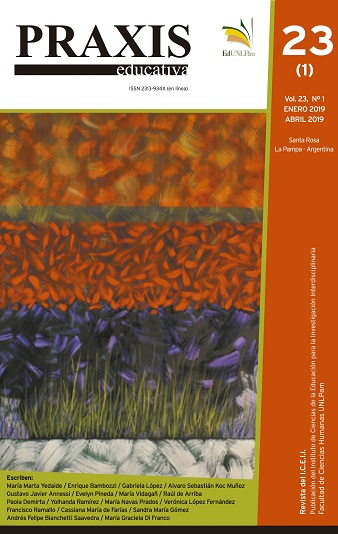The teaching of social sciences in primary school Analysis of teaching Approaches within the Digital Classroom
Keywords:
social sciences, primary, TICE (Educational Information and Communication Technologies).Abstract
The general problem that guides the work is related to the use of Information Technology and Educational Communication (TICE) that teachers do in Social Sciences classes in primary schools. The methodology used was to make a cut of the reality, to focus on three different moments of a didactic situation. First of all, an interview with the teacher focused on the planning of the didactic sequence to be implemented, a second moment of observation and recording of the didactic activity through the videocopy technique, and for the last time a self-confrontation interview. The analysis aims to show, in a general way, how teachers in social science classes make use of the Digital Mobile Classrooms (ADM).
Downloads
References
Annessi, G. y Lomberg, A. (2012). La Actividad Didáctica mediada por Tecnologías de la Información y la Comunicación Educativa. En Geografía en Escuelas de Nivel Secundario de Argentina. XVII Congrés Mondial AMSE. Reims: Université de Reims.
Artigue, M. (2002). Learning Mathematics in a CAS Environment: The Genesis of a Reflection about Instrumentation and the Dialectics between Technical and Conceptual Work. International Journal of Computers for Mathematical Learning, 7(3), 245–274.
Artopoulos, A. (2010). De la “computadora florero” al celu-bot: sobre la difusión de tecnologías en educación. En Kosak, D. Escuela y TICs: los caminos de la innovación (pp. 19-36). Buenos Aires: Lugar Editorial.
Cabello, R. (2006). Yo con la computadora no tengo nada que ver. Un estudio de las relaciones entre los maestros y las tecnologías informáticas en la enseñanza. Buenos Aires: Prometeo Libros.
Dussel, I. y Quevedo, L. (2010). Educación y nuevas tecnologías: los desafíos pedagógicos ante el mundo digital. Buenos Aires: Santillana.
Kosak, D. (2010). Escuela y TICs: los caminos de la innovación. Buenos Aires: Lugar Editorial.
Mauri, T. y Onrubia, J. (2008). El profesor en entornos virtuales: condiciones, perfil y competencias. En Coll, C. y Monereo, C. (Coord.). Psicología de la educación virtual (132-152). Madrid: Morata.
OECD (2010). Are the New Millennium Learners Making the Grade? Technology Use and Educational Performance in Pisa. Recuperado de
http://browse.oecdbookshop.org/oecd/pdfs/browseit/9609101E.PDF (consulta 05-11-2014).
Rickenmann, R. (2001). Sémiotique de l’action éducative. En Baudouin, J.M. y Friedrich, J. (Ed.), Théories de l’action et éducation (p. 225-254). Bruselas: De Boeck.
Rickenmann, R. (2007a). Investigación y formación docente: dispositivos de formación y elementos para la construcción de una identidad profesional. Revista EcoS, 9(2), 435-463.
Rickenmann, R. (2007b). Metodologías clínicas de investigación en didácticas y formación del profesorado: un estudio de los dispositivos de formación en alternancia. Suiza: Universidad de Ginebra.
Rickenmann, R. (2007c). El rol de los artefactos culturales en la estructuración y gestión de secuencias de enseñanza-aprendizaje. Suiza: Universidad de Ginebra.
Rickennann, R. y Lagier, C. (2008). Analyse sémiopragmatique des transactions didactiques: transformations du milieu didactique et développement des conduites professionnelles. En Filliettaz. L. & Schubauer-Leoni, M. Processus interactionnels et situations éducatives. Bruxelles: De Boeck.
Sensevy, M. y Schubauer, L. (2000). Vers un modèle de l’action didactique du professeur. A propos de la course à vingt. Recherches en didactiques des mathématiques, 20(3), 263-304.
Sensevy, M. y Schubauer, L. (2007). Categorías para describir y comprender la Acción Didáctica. Traducción R. Rickenmann.
Verillon, P. y Rabardel, P. (1995). Cognition and artifacts: A contribution to the study of though in relation to instrumented activity. En European Journal of psychology of education. 10 (1), 77-101, DOI: 10.1007/BF03172796.
Vidal Puga, M. (2005). Integración de las tecnologías de la información y la comunicación (TIC) en una escuela primaria de Galicia. Estudio de caso (Tesis Doctoral). Universidad de Santiago de Compostela.
Downloads
Published
Issue
Section
License
Copyright Notice
Editorial Committee Educational Praxis Magazine:
I hereby declare that I am the author of the article titled (article name), that it is original and my own and that it was not previously published in any other format or medium. I declare to know that the magazine will not charge me any type of fee under any circumstances, nor will I receive any type of monetary compensation If it were accepted for publication in Educational Praxis, I authorize the aforementioned magazine to publish it digitally and to advertise it on its social networks.
If the work is published, I adhere to the Creative Commons license called "Attribution - Non-Commercial Share Alike CC BY-NC-SA", through which it is allowed to copy, reproduce, distribute, publicly communicate the work and generate derivative works, as long as when the original author is cited and acknowledged. This license has been used since September 2018. In 2016 CC BY NC ND 4.0 was adhered to; and in the years 2017 and 2018 (January-August) CC BY NC 4.0.
This CC BY-NC-SA Share Alike license does not, however, permit commercial use of the work. As an author, the journal may establish additional agreements for the non-exclusive distribution of the version of the work published in the journal, it allows me to self-archive the published articles, in their post-print version, in institutional, thematic repositories, personal web pages or any other relevant use. with the recognition of having been first published in this journal.
Educational Praxis adheres to DORA (Declaration on Research Assessment) signed in San Francisco, California, on December 16, 2012, and to the Declaration of Mexico (Joint Declaration LATINDEX - REDALYC - CLACSO - IBICT).











_(1)2.png)


3.png)











_(2).png)






2.jpg)









